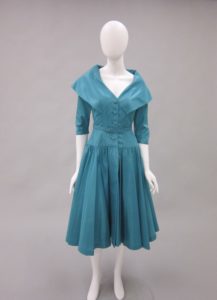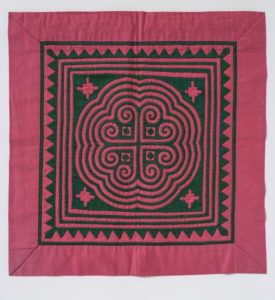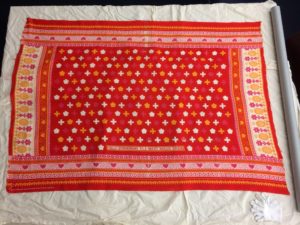Story by Doreen Beard

What do Dior, African khanga cloth, and Hmong textiles have in common? They are part of the upcoming exhibitions that will be installed in the Avenir Museum of Design and Merchandising galleries over the summer; look for more in-depth features and images of these wide-ranging design and textile topics in the Avenir’s Fall 2018 newsletter.

Dior’s New Look in the Everyday American Closet
(August 6, 2018 – January 4, 2019)
French couturier Christian Dior (1905-1957) was one of the most influential fashion designers of the twentieth century. His ‘New Look’ debuted in 1947; its feminine silhouette and voluminous fabric yardages quickly seduced post-World War II style-setters. But far from the boulevards of Paris, how did the everyday American woman aspire to achieve Dior’s ‘New Look’? This exhibit showcases apparel objects from the Avenir Museum collection that are not Dior brand but represent the pervasive influence on fashion of the ‘New Look’ silhouette. The Avenir exhibition Dior’s New Look in the Everyday American Closet will complement the Denver Art Museum’s upcoming exhibit Dior: From Paris to the World, which will be on view in downtown Denver from November 19, 2018, to March 3, 2019.

Cloth as Community: Hmong Textiles in America
(September 10 – December 21, 2018)
The Hmong are people indigenous to the mountain regions of Southeast Asia, many of whom are now dispersed throughout the world by the disruption of war and refugee experience. The exhibition charts the evolution of the rich Hmong textile culture, from geometric ornamental cloth forms to embroidered story cloths, and the blending of traditional motifs with representations of new lives and the creation of community in America. Cloth as Community: Hmong Textiles in America is a program of ExhibitsUSA, a national division of Mid-America Arts Alliance and The National Endowment for the Arts; its exhibition at Colorado State University is made possible by the generous support of The Sophie and Ted Aldrich Asian Textile Fund of the Avenir Museum.
“Armed with Proverbs”: Khanga Cloth in Africa
(August 27, 2018 – January 18, 2019)

The name for this exhibition comes from a line in the 2008 poem I Am Khanga by Khwezi of South Africa. The poem speaks to the purpose and power of khanga cloth, a light-weight printed cotton worn primarily by women in several countries across the African continent. Khanga first appeared in the late 1800s in East Africa. Its origins as an Indian fabric later produced in Europe, China, and Africa are as eclectic as its many uses. A versatile rectangular length of cloth, the khanga is used as a wrapper, for carrying goods and for holding children. The design printed on the fabric always has a four-sided border, a motif inside the border, and a proverb or phrase usually written in Kiswahili. The language written on the fabric is a silent but literate method of communication for the wearers, who use khanga to express themselves as both individuals and as community members through the cultural and political meanings of the statements on their khanga.
New Threads
(Ongoing)
Showcasing the Avenir Museum’s most recent acquisitions, New Threads examines what makes textile or apparel objects “museum worthy” for acceptance into our collection. Fall 2018 will features a breadth of garments and flat textiles such as: a contemporary American tapestry demonstrating both pulled warp and slit-weave techniques; a complete World War II 17th Airborne Division gliderman’s uniform donated by its original owner, who returned home from war to became a professor of veterinary medicine at CSU; and, a traditional embroidered cloth baby carrier of the minority Miao people of China.
The Avenir Museum of Design and Merchandising is part of the Department of Design and Merchandising in CSU’s College of Health and Human Sciences.